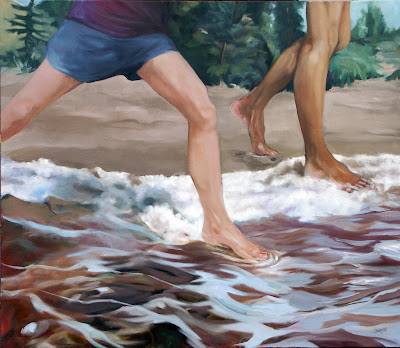There’s no ‘there’ there to rebel against anymore.
 |
| Winter Lambing, 48X36, available, Carol L. Douglas |
My goddaughter Sandy is the child of immigrants. Her family escaped China at the conclusion of the Civil War, when it was clear the communists had won. They went to Vietnam, which has an active community of Chinese emigres. After the fall of Saigon in 1975, they became Vietnamese boat people, ultimately ending up in the US. (For many reasons, let us hope that this time their refuge is secure.)
“Americans are in a constant state of rebellion against their parents,” Sandy observed as we did our daily constitutional up Beech Hill yesterday. “Why is that?” For Asians, filial piety is a virtue.
 |
| Wreck of the S.S. Ethie, 24X18, Carol L. Douglas |
I’m familiar with some of the roots of that rebellion, being a product of the Swinging Sixties myself. But it goes farther back, to the Roaring Twenties. Both the 1920s and the 1960s are thought by historians to be periods of nihilism in response to the cataclysm of world war, but that’s an incomplete explanation. The American Civil War was the greatest cataclysm in American history, and no such period followed it. The closest we came was the anarcho-communism of the turn of the century.
In art, we’ve been at this business of rebellion ever since the Impressionists showed in the first Salon des Refusésin 1863. We’re now in a position where vast sums of money are exchanged for intangible art. If there’s anything left to rebel against, I can’t see it.
 |
| Deadwood, 48X36, Carol L. Douglas |
“Where is art going?” is a question every thinking artist should constantly ask himself. For our predecessors there were clear trends (although I’m sure they are clearer in retrospect). The past filled the galleries, and the bright young things were all in the coffee house complaining about it.
It’s harder for today’s young artist. The most obvious means to success is to make a spectacle of oneself, but that’s a different artform altogether. There are digital art and electronic installations, but for a painter, it’s difficult to see a direction in the current maelstrom. When plein air shows happily embrace abstraction and great galleries laud incompetence, there’s nothing left to push against.
 |
| All flesh is as grass, 36X48, Carol L. Douglas |
One answer is to become more international in our viewpoint, to import other cultures’ attitudes about art. After all, we live in a global world. That’s a mixed bag, of course. Asian artists honor technique, but their governments don’t necessarily honor intellectual property rights.
I see certain trends in my little niche of landscape painting. As the digital world shapes our seeing, chroma (intensity) in painting increases. Detail decreases. But these are merely stylistic flutters. We’ve seen them come and go before. They’re meaningless in the bigger scheme of things.
Of course, I don’t have an answer to this question, or I’d already be doing it.







